Building Return on Investment from Cloud Computing – Building Return on Investment from the Cloud
The central theme of this White Paper is how to go beyond the initial capacity and utilization benefits described in Cloud Computing.
The view of capacity and utilization is a technology provider/seller viewpoint which is essentially based on key performance indicators (KPIs) rather than business benefit metrics.
- IT capacity, as measured by storage, CPU cycles, network bandwidth, or workload memory capacity is an indicator of performance.
- IT utilization, as measured by uptime availability and volume of usage is an indicator of activity and usability.
But effective cost/performance ratios and levels of usage activity do not necessarily imply proportional business benefits. They are just indicators of business activity that are not in themselves more valuable than lower operating cost. There are, however, business metrics that translate the indicators of the capacity-utilization curve to direct and indirect benefits to the business, as illustrated in Figure 5.
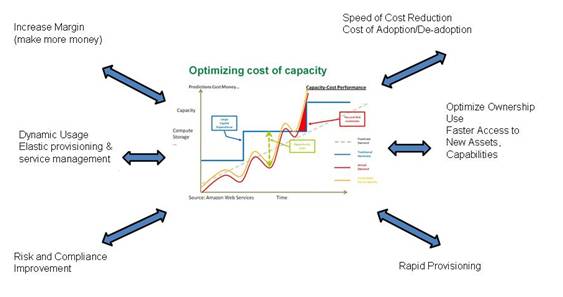
Business Metrics Derived From Capacity/Utilization
These metrics are described in the following sections.
Speed of Cost Reduction – Cost of Adoption/De-Adoption
The introduction of Cloud Computing as an option transforms cost of ownership and changes the dynamics of the provisioning cycle in a number of fundamental ways.
The speed and rate of change of cost reduction can be much faster using Cloud Computing than traditional investment and divestment of IT assets. In Cloud Computing the buyer can move from a CAPEX to an OPEX model through purchasing the use of the service rather than having to own and manage the assets of that service. This responsibility is transferred to the service provider.
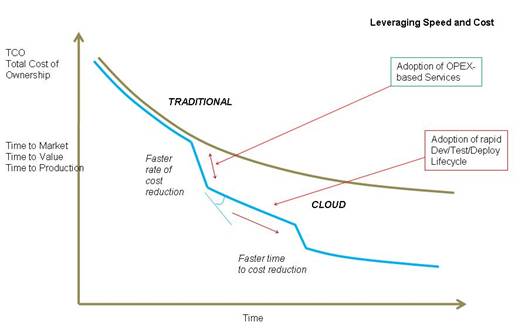
Speed of Cost Reduction, Cost of Change
The use of Cloud Computing to the user also potentially means a movement to a pay-as-you-go style billing model which can have different tariffs and contractual obligations compared to traditional IT ownership. These can include minimum usage periods and flexible pricing per usage profiling (see the discussion on the Financial Value Perspective of Moving from CAPEX to OPEX and Pay-as-you-go).
The key issue is the ability to adopt and remove the service either at the point of use (to scale up and down) or to make choices to use new services or change service provider.
Migration between Cloud services is still a challenge. There are portability and interoperability issues.. And hosting corporate and personal data and knowledge on the Cloud can make customers of Cloud services dependent on the providers.
There is a trade-off between the benefits of speed, cost, and Quality of Service (QoS) from a particular Cloud service provider and their ecosystem of services versus the flexibility and choice of alternative services and Cloud solutions.
The cost of change in an ROI business case is less in Cloud Computing as the choice of selected Cloud services is more stable and more cost-effective than traditional ownership.
Optimizing Ownership Use
The use of IT has become an enduring feature in all organizations today. The investment in data, knowledge, and infrastructure assets and software code now represent many lifeblood operations for businesses.
But many of the issues of cost of ownership are often decoupled from choices made during selection of new IT, and the impact on the long-term running and maintaining of these IT services and subsequent business usage is not properly considered:
- Technology design choices and purchasing are often done by strategic or tactical contractual purchasing based on project requirements, with little consideration for optimizing running and maintainance over the whole system lifecycle, but
- The cost of maintenance and modifications often represent a significant part of the asset lifecycle beyond initial provisioning.
The ability to “design and provision for run”, so that the choices of IT procurement are aligned with the best options and performance for long-term operation, has long been an ideal goal of business and IT. But, while technical trends such as OO, SOA, and Web 2.0 have brought functional improvements, the improvements in runtime infrastructure support have always been illusive.
A key aspect of moving to Cloud Computing is the ability to select hardware, software, and services from defined design configurations to run in production. Cloud Computing in effect seeks to bridge the design-time and run-time divide and optimize service performance. Patches and upgrades or new technology are in theory invisible to the end user of the service as they are included as part of the automatic asset management features.
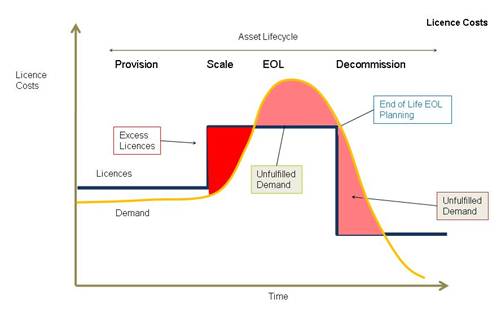
Optimizing Ownership Use
Cloud Computing can help an enterprise achieve the goal of a more cost-effective asset–management lifecycle process for the IT portfolio, to optimize both design and run-time performance.
While the capacity-utilization curve can reflect overall usage, this can be broken down to identify which assets need to be supported in this way and to rationalize, consolidate, and optimize the assets that need to perform for business goals.
The key benefits to Cloud Computing ROI from a business case perspective are in the optimization of the total asset portfolio.
Rapid Provisioning
Elastic provisioning to scale up and down to actual demand creates a new way for enterprises to scale their IT to enable business to expand.
The provisioning time compression from a week to hours, for example, demonstrated by Cloud Computing sellers/providers is a means to rapid provisioning that is not just about saving time but is also defining a new business operating model.
Organizations can review and develop business plans and then deploy infrastructure and services in a more rapid and proactive way.
Customization and development, testing, and support can also been seen in a new light with the provision of IT services in a dynamic fashion targeted at business needs.
Buyers and sellers can view rapid provisioning as a marketplace of services. Sellers can offer rapid provisioning services that sustain buyer needs for existing IT services, offer choices for innovation, and enable rapid introduction of new technology.
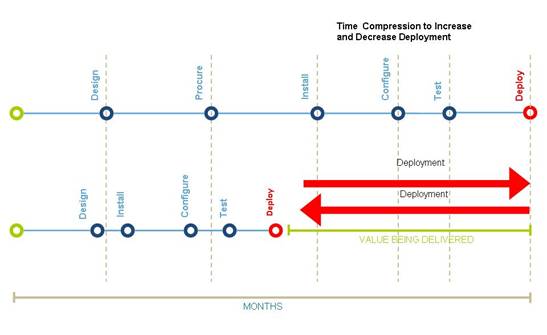
Optimizing Time to Deliver/Execution
The impact of rapid provisioning on ROI business cases can be profound. Examples in the government/federal sector as well as financial services and consumer goods are already evident and pointing the way to the emergence of online Cloud-based marketplaces as de facto standards for current and future trading between suppliers and buyers of services.
Increase Margin (Make More Money)
One of the core precepts of Cloud Computing is to avoid over-provisioning and under-provisioning. This is in addition to the opportunity for cost, revenue, and margin advantages of business services enabled by rapid deployment of Cloud services with low entry cost, and the potential to enter and exploit new markets.
What makes Cloud Computing exciting is that the potential for business is not just the incremental change improvement but the disruptive transformational effect Cloud Computing can have from the possibilities of new business operating models.
Cloud Computing enables business to pursue new and existing markets by rapid entry and exit of the products and services. It enables enterprises to “land and expand” in markets with an infrastructure and service capacity that can grow with the business.
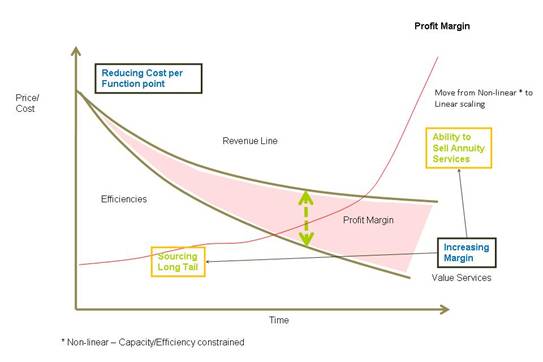
Optimizing Margin
Cloud Computing removes the need for additional infrastructure to test and enter markets for business (a key benefit feature particularly for small to medium size organizations).
Cloud Computing has an impact on the margin through cost reduction and through economies of scale to make more use of the same resources.
The impact on a ROI business case is that an enterprise can make more money or better use of existing investments through Cloud Computing.
There are many cases of companies large and small that can enter and develop service offerings through a “long tail” (refer to the publication by Chris Anderson [7]) approach enabled by Cloud Computing infrastructure. Existing and new markets can be attacked and entered through speculative and well-timed interventions to exploit and grow business performance.
Dynamic Usage – Elastic Provisioning and Service Management
The focus on capacity and utilization can be taken further through arrangements with Cloud Computing service providers/sellers that enable dynamic usage provisioning.
Traditional licensing associated with ownership, number of users, support, and maintenance costs and services are being challenged by the pay-as-you-go model found in on-demand Cloud Computing.
Cloud Computing is more than restructuring software and hardware and support licenses into a kind of periodic rented or lease license. It is targeting the end usage of the services at the point of real business need of the number and scope of users of the IT service (see the discussion on the Importance of a Business Perspective of the Cloud).
With either fixed usages volumes or variable functional usage, new innovative consumption models enabled by Cloud Computing allow businesses to consider using IT in a flexible and agile way.
This can range from the “freemium”, “contractless” service that you use or pay by credit card and advertizing revenues or specific pre-allocated bands of services and software functionality over a defined period of use (see the discussion on the Financial Value Perspective of Moving from CAPEX to OPEX and Pay-as-you-go).
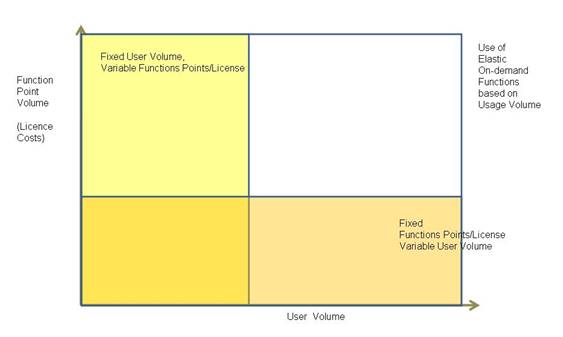
Elastic Provisioning
Cloud Computing can change the ownership process from buyer to seller in the sense that IT becomes a commodity purchase, and buyers focus on outcome-based performance and choices.
The impact of dynamic provisioning on the Cloud Computing ROI business case is that the façade of service management becomes more “digital”. With the emergence of Internet services, it is now commonplace in residential markets for services and products to be viewed and provisioned online.
This expectation is now translated via Cloud Computing into the business world, where online service catalogs, self service, and automated services are increasingly part of the consumer experience.
Risk and Compliance Improvement
The green sustainability issue is equally valid in Cloud Computing and seen by a number of industry observers as an argument that moving into a Cloud environment will help organizations improve their carbon footprint.
This perhaps shifts the problem to the Cloud service providers as their industry potentially becomes a huge sink for electrical emissions from massive scale computing data center services.
It is expected that this challenge will be met as technological and design improvements address the energy consumption growth patterns. The benefit to the economic and emission footprint from the use of shared services is expected to have an improved impact compared to leverage of existing assets.
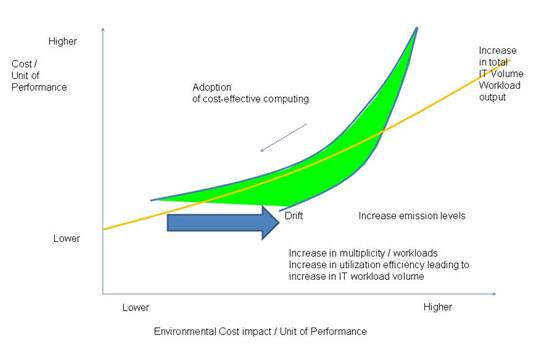
Green Costs of Cloud – Sustainability
A secondary effect, however, is the growth of more Cloud service users as the Cloud Computing paradigm takes off. As the cost and emission footprint per Cloud service falls, more services per cost can be consumed. As more advanced services emerge (the term “multiplicity” – see [8] – is now starting to emerge as large workload and cost-sensitive processing is moved to the Cloud and multiple processing made possible) then so can “usage creep” occur as the consumption rates further increase the usage of Cloud Computing services.
The alignment of compliance is a wider issue that includes green and legislative issues facing organizations and specific industry sector policies.
The impact on the ROI business case from using Cloud Computing services is directly relevant to sovereignty, security, and management of services risk containment. Cloud Computing domains cut across these complex issues and are directly affected by decision processes to adoption off-premise services.